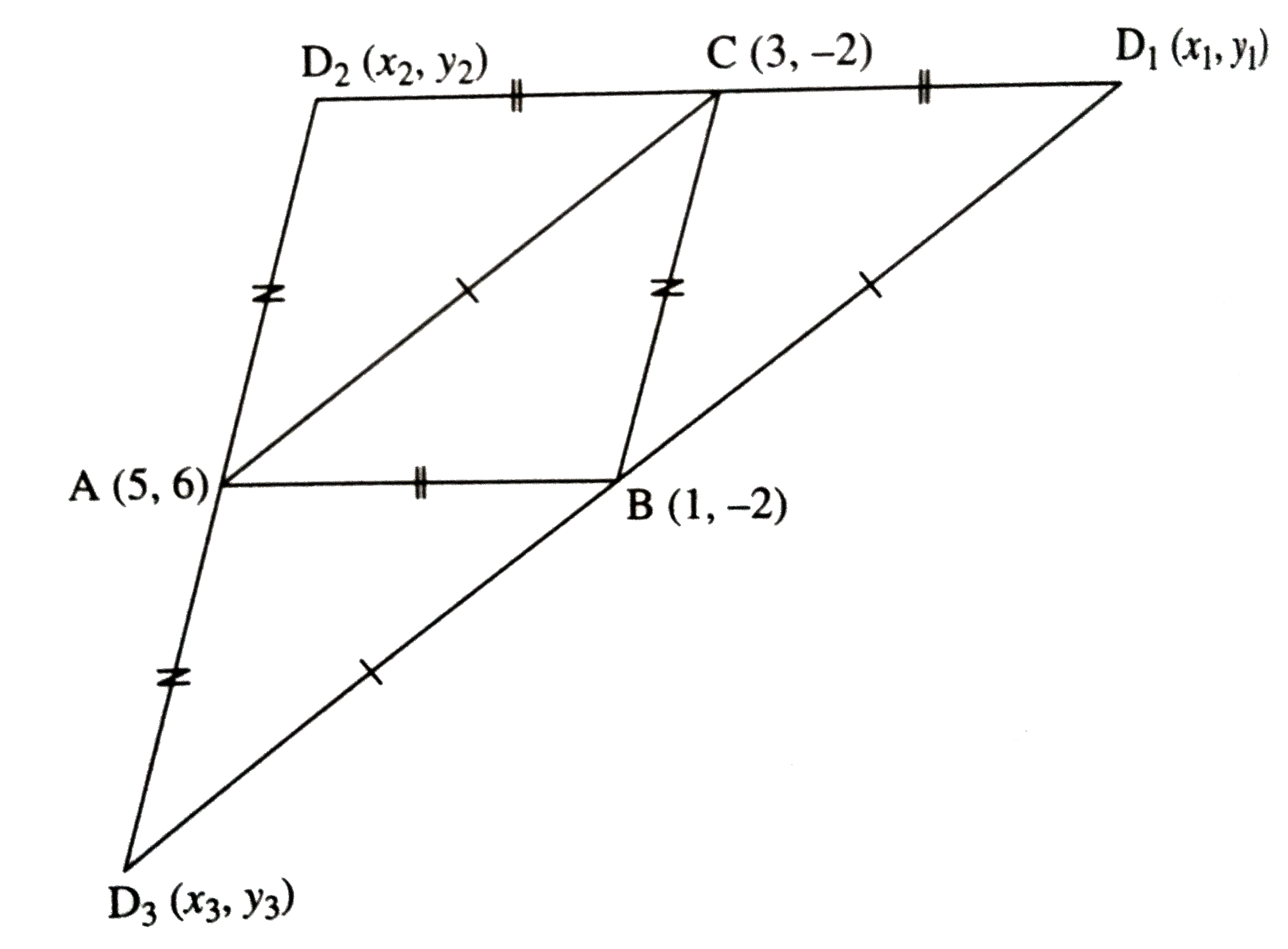Find the possible pairs of co-ordinates of the fourth vertex D of the parallelogram, if three of its vertices are A(5,6),B(1,2)andC(3,−2)
Video Solution
Text Solution

A(5,6),B(1,−2) and C(3,−2) are the vertices of a parallelogram.
There can be three possibilities of the location of the vertex D, say D1(x1,y2),D2(x2,y2) and D3(x3,y3) as shown in the figure.
□ABD1C is a parallelogram.
∴AB=CD1
......(Opposite sides of parallelogram are equal ) .........1
also □ABCD2 is parallelogram.
∴AB=CD2
.........(Opposite sides of parallelogram are equal) ..........2
∴ From 1 and 2
CD1=CD2
∴C is the midpoint of D2D1.
Similarly B is the midpoint of D1D3
and A is the midpoint of D2D3
Now C is the midpoint of D2D1
∴ by midpoint formula
3=x2+x12
∴x1+x2=6 .............3
Similarly x2+x3=10.......4
and x1+x3=2.........5
Adding 3, 4 and 5 we get
x1+x2+x2+x3+x1+x3=6+10+2
∴2x1+2x2+2x3=18
∴2(x1+x2+x3)=18
∴x1+x2+x3=182
∴x1+x2+x3=9.....6
Substituting 3 in 6 we get
6+x3=9
∴x3=9−6
∴x3=3
Substituting 4 in 6 we get
x1+10=9
∴x1=9−10
∴x1=−1
Substituting 5 in 6 we get
x2+2=9
∴x2=9−2
∴x2=7
∴x2=7
C is the midpoint of D2D1.
∴ by midpoint formula,
−2=y1+y22
∴y1+y2=−4..7
Similarly y2+y3=12............8
and y1+y3=−4.....9
Adding 7, 8 and 9 we get
y1+y2+y2+y3+y1+y3=−4+12−4
∴2y1+2y2+2y3=4
∴2(y1+y2+y3)=4
∴y1+y2+y3=42
∴y1+y2+y3=2.....10
Substituting 7 in 10 we get
−4+y3=2
∴y3=2+4
∴y3=6
Substiting 8 in 10 we get
y1+12=2
∴y1=2−12
∴y1=−10
Substituting 9 and 10 we get
y2+(−4)=2
∴y2−4=2
∴y2=2+4
∴y2=6
The coordinates of point D1 are (−1,10)
The coordinates of point D2 are (7,6).
The coordinates of point D3 are (3,6).
The possible pairs of coordinates of the fourth vertex D of the parallelogram are (−1,−10),(7,6) and (3,6).
|
Updated on:21/07/2023
Similar Questions
Knowledge Check
- Question 1 - Select One
The fourth vertex D of a parallelogram ABCD whose three vertices are A(−2,3), B(6,7) and C(8,3)is
A(0,1)B(0,−1)C(−1,0)D(1,0) - Question 2 - Select One
What is the fourth vertex of a parallelogram, if its three consecutive vertices are (-2,-1), (1,0) and (4,3)?
A(0,−2)B(2,2)C(2,1)D(1,2) - Question 3 - Select One
Find the fourth vertex of the parallelogram whose three consecutive vertices are (8,8),(6,1) and (−1,1) .
A(1,8)B(2,9)C(3,7)D(4,5)
The fourth vertex of a parallelogram,whose consecutive vertices are (3,−4),(−2,1)and(-6,5) is
View SolutionWrite the coordinates os the fourth vertex of a square when three of its vertices are given by (1,2) (5,2) (5, -2).
View SolutionFind the third vertex of ΔABC , if two of its vertices are A (-2,3) , B(4,5) and its C(1,2) .
View SolutionThe fourth vertex D of a parallelogram ABCD whose three vertices are A(−2,3),B(6,7)andC(8,3) is
(a) (0,1)
(b) (0,−1)
(c) (−1,0)
(d) (1,0)View SolutionThe vertices of a parallelogram in order are A(1,2), B(4, y), C(x, 6) and D(3,5). Then (x, y) is
View Solution

